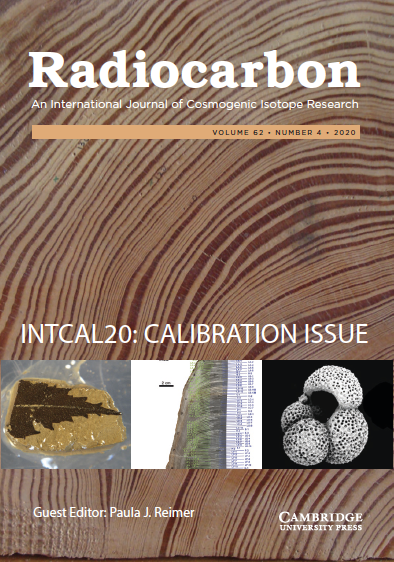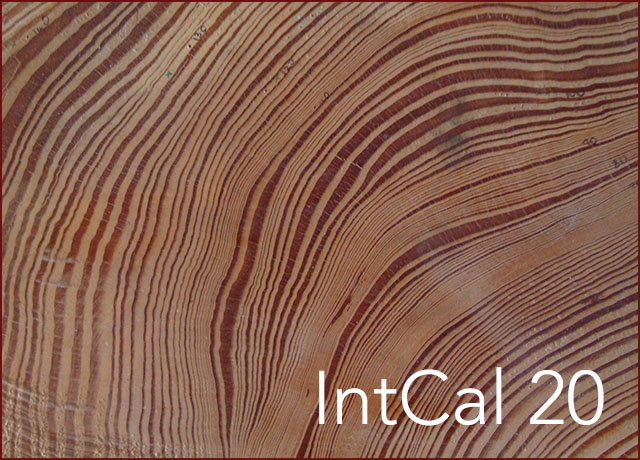Radiocarbon Dating, Calibration & Databases
Calibration & Intercomparison Resources
IntCal20 in Vol. 62(4), 2020 of Radiocarbon.
- Read the latest news, featured in Nature:
- "Carbon dating, the archaeological workhorse, is getting a major reboot. A long-anticipated recalibration of radiocarbon dating could shift the age of some prehistoric samples hundreds of years."
- NEW! Ahead of the issue publication, the much-anticipated articles IntCal20, SHCal20, and Marine20, as well as a statisics overview by Heaton et al., will be online at FirstView by 5 p.m. BST (12 p.m. EDT) on Aug. 12, 2020! Search here for links to IntCal20 articles in Radiocarbon as they are published.
- Click here for past Calibration issues.
Do you have an item you would like to have dated?
Please note Radiocarbon is a journal, not a dating lab. Please check our list of laboratories for a radiocarbon lab near you, or contact the NSF AMS Lab at the University of Arizona.
Are you looking for an overview of the radiocarbon method?
There are many helpful sites on the Internet. Here are just a few:
C14dating.com http://www.c14dating.com/int.html
Univ. Arizona AMS lab https://ams.arizona.edu/radiocarbon
GNS Science AMS lab https://www.youtube.com/watch?v=-xKvq6VLe4s
Univ. Arizona Tree Ring Lab http://ltrr.arizona.edu
For Research Professionals...
IntCal data and related links. (Please scroll down on this page for links to computer programs.)
SIRI update. SIRI article published October 2017.
Computer Programs
(Please leave a comment at the bottom of the page to report errors or suggest links.)
CALIB Home Page. One site, many major programs: CALIB, Marine Reservoir Correction, CALIBomb, IntCal20, IntCal13, SHCal13, IntCal09.
OxCal by Christopher Bronk Ramsey. This is an online radiocarbon calibration program with downloadable versions for Windows and Mac platforms. The program can be used for calibration of dates using the IntCal curves or post-bomb data. Comparisons can also be made to any user-supplied data-set. The package also allows Bayesian analysis of sequences, phases, tree-ring sequences, age-depth models, etc. There is an online manual.
BCal: Online Bayesian radiocarbon calibration tool. Developed at the Department of Probability & Statistics, University of Sheffield (UK), this allows users to obtain calibrated dates on data sets entered via a Web browser.
CalPal: Cologne Radiocarbon CALibration and PALaeoclimate Package. Designed for research on glacial C-14 age conversion (PC-WIN). By Bernhard Weninger and Olaf Jöris.
WinCal25: The Groningen Calibration Program: By J. van der Plicht, for Windows, upgraded with latest calibration data set (intcal04). WinCal25 is a Windows remake of the CAL25 DOS program. It has the same functionality as CAL25 but with a new user interface..
Metabase: laboratory data management software system that can be used by LSC labs.
Fairbanks calibration program by Richard G. Fairbanks. As described in: "Marine Radiocarbon Calibration Curve Spanning 0 to 50,000 Years B.P. Based on Paired 230Th/234U/238U and 14C Dates on Pristine Corals," by Richard G. Fairbanks, Richard A. Mortlock, Tzu-Chien Chiu, Li Cao, Alexey Kaplan, Thomas P. Guilderson, Todd W. Fairbanks and Arthur L. Bloom, 2005. Quaternary Science Reviews 24:1781-1796.
[ Defunct ] Fairbanks Marine Radiocarbon Reservoir Age Program developed by Richard Fairbanks, Naomi Naik and Li Cao at the Lamont Doherty Earth Observatory for use with the Fairbanks Radiocarbon Calibration Program. Users can view and make maps and compute estimates for the Marine Radiocarbon Reservoir Age of the surface ocean based on model and measured radiocarbon reservoir age estimates. The program operates on the Google Earth and Google Map application engines and features overlay data sets particularly useful for interpreting the radiocarbon reservoir age estimates.
Radiocarbon Databases and Searchable Indexes
ArqueoData
ArqueoData is a freeware-type, collaborative, open-access database. Here you will find a compilation of radiocarbon dates of archaeological sites in Latin American countries. ArqueoData is part of a project by BetoASaber.com, the main website of Alberto Alcántara.
Radiocarbon Database for the Cenral Andes: https://andesc14.pl/en/.
IntChron index site of chronological and environmental data, which integrates, pulls up, plots and archives records.
Canada
Canadian Archaeological Association. Links to archeology resources.
Canadian Archaeological Radiocarbon Database (CARD). A compilation of radiocarbon measurements that indicate the ages of samples primarily from archaeological sites in North America.
Southeast Asia and Anatolia
14Sea Project: 14C database of Anatolia, the Aegean, and southeast Europe available in downloadable Excel files.
United Kingdom
Archaeological site index to radiocarbon dates from Great Britain and Ireland: database of over 4000 dates from the British Isles. Description of the database. Search access via the Archaeology Data Service catalogue. Oxford Radicarbon Accelerator Unit (ORAU) Datelist Index.
United States
NOAA Earth System Research Library (ESRL) 14CO2 data and Carbon Dioxide Information Analysis Center (CDIAC) data. National Geophysical Data Center Paleoclimatology Home Page. National Geophysical Data Center Radiocarbon datasets.
Email List
C14-L is an email list for researchers and others involved in radiocarbon and other radioisotopes used in dating, and in scientific dating issues in general. Disciplines for which it should be of particular interest would include anthropology, archaeology, climate and environmental studies, dendrochronology, earth sciences, oceanography, and various branches of chemistry and physics.
The C14-L list is intended primarily for technical communication and is not an appropriate forum for uninformed debate over the premises or theological implications of dating methods, since talk.origins and other Usenet groups and Listserv lists already handle that function admirably. The listowner reserves the right to implement moderation if that charter stipulation is ignored.
-
To subscribe, send a message to c14-l-request@list.arizona.edu
In the subject you may indicate SUBSCRIBE. This is a self-subscribe list, and while the list moderators will be notified, their approval is not needed. You will receive a welcome message almost immediately and you are ready to post.
-
To post to the list, email c14-l@list.arizona.edu
- Log in to post comments


